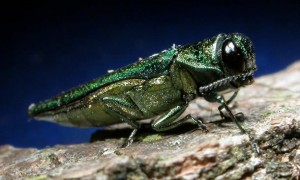By Nellie Brown
One of the comments on my earlier post about possible effects of our recent winter on Emerald Ash Borer (EAB) stated:
“A recent study in Minnesota exposed emerald ash borer larvae to extremely cold temperatures, and they died. However, the larvae in this experiment were exposed to the extreme cold without any gradual acclimatization.”
This is factually incorrect. Insects in the study were winter-acclimated and we know that the bark provides about 1°C of a buffer from air temperature at night. Some news agencies somehow start reported that the insects weren’t acclimated and somehow that rumor has persisted. I’d suggest reading the study:
http://www.fs.usda.gov/Internet/FSE_DOCUMENTS/stelprdb5191794.pdf

Photo from www.emeraldashborer.info
I based my comments on this article, posted on the EAB website, which is usually quite reliable. After reading the original study, I believe the scientific methods were valid. I appreciate the correction, and I encourage the authors to submit their research article to the EAB website, which is generally regarded as the best source of accurate information for many people interested in this subject.
The results sound promising for far northern areas in the U.S. and Canada. However, most areas affected by EAB in the lower 48 states of the U.S., including St. Louis, do not meet the parameters evaluated in this experiment. Our coldest temperature recorded by NOAA this winter was -8°F (-22°C). This is very cold for St. Louis, but not cold enough to kill EAB larvae based on these research findings (-13°F/-25°C). This is probably true for the rest of Missouri as well.
EAB continues to be found this spring in new areas south of Minnesota and north of Missouri in areas far outside the heat islands of larger cities, as well as in other parts of the expanding range in North America (source).
So, while my initial response was based on a misunderstanding of the original study, I stand by my conclusions:
- EAB will continue to be a threat in Missouri and much of the lower 48 states.
- You should burn firewood in place and follow state and federal quarantines to help prevent the spread of this invasive pest.
- Plant a diversity of native species in your landscape to reduce the impact of future calamities. In other words, “Don’t put all your eggs in one basket.”


Thanks for the update even if not the news we wanted.